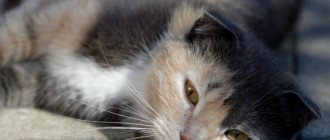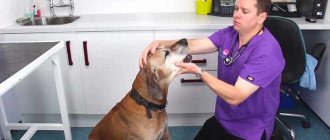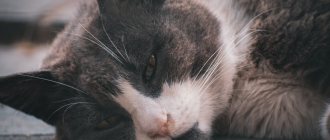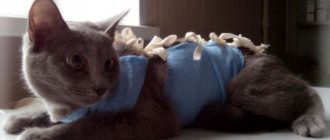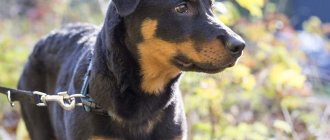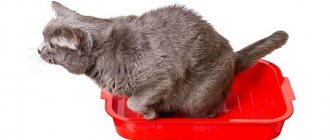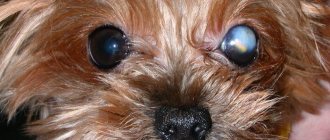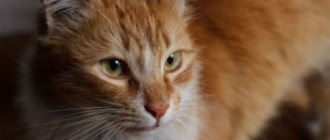Domestic cats often experience inflammation of the paraanal glands. However, many owners do not even know that their pet has them and what functions these glands perform. So that you can help your cat in a timely manner and prevent consequences dangerous to its health, see the most useful information about the signs and causes of inflammation of the paraanal glands.
Read in this article:
What are paraanal glands? Common causes of inflammation Signs of inflammation and abscess Treatment: main stages and methods
- Cleaning
- Washing
- Removal
Recovery after treatment Prevention of inflammation of the paraanal glands
What are paraanal glands?
Anal (paraanal) glands are paired glands located at the anus. They look like small “bags” and secrete a secretion that performs various functions. One of them is recognizing the opposite sex and attracting them for further mating.
Other functions performed by the paraanal glands:
- protection from enemies (scaring away),
- marking the occupied territory,
- maintaining metabolism in the body,
- attracting partners.
During inflammatory processes, the functions of the glands are disrupted. Because of this, the pet experiences serious discomfort. In advanced cases (for example, with the development of an abscess), this problem can lead to serious and irreversible consequences. However, it is possible to avoid them if you know all the most important things about the causes and signs of inflammation.
When do cats and dogs need to have their anal glands cleaned?
Usually these glands are completely cleared when stool is released. This is a natural process and there is no need to interfere with it.
But in some cases they can become clogged, and then the normal removal of secretions from the pet’s body is disrupted. If the bags are overfilled, the well-being of the “tail” deteriorates sharply. In such a situation, an urgent visit to a veterinarian is necessary. If treatment of the inflamed organ is not started in time, pathogenic bacteria begin to multiply in it. An infection gradually develops, which can result in suppuration.
The most common causes of blockage of the paraanal glands are:
- inflammatory process;
- genetic factor;
- diseases of the digestive system;
- constipation;
- helminth infection;
- infection;
- improperly formed dog diet with a predominance of protein foods or bones;
- lack of hygiene;
- weakening of the body's defenses.
Most often, the problem with gland blockage occurs in pets of small breeds (pugs, Pekingese, dachshunds, Shih Tzu, Spitz, etc.) They move too little, which is why their feces soften significantly, disrupting the normal process of bowel movements. Most often the disease affects pregnant and lactating females.
Common Causes of Inflammation
Inflammation or abscess of the paraanal glands often develops with trauma and mechanical damage to this area (for example, falls from a great height). This leads to dysfunction of the glands, disruption of the outflow of secretions and its subsequent accumulation. All this provokes the development of an inflammatory process involving pathogenic microflora.
Most often, long-haired cats living in apartments face the problem of inflammation of the paraanal glands. This is due to the fact that they lose the natural ability to cleanse the anal sacs (due to the absence of potential enemies and the need to defend themselves from them).
Common causes of inflammation of the paraanal glands:
- dysbacteriosis (for example, due to prolonged use of antibiotic drugs by the pet),
- helminthic infestations,
- eating small bones
- feeding mass market liquid food,
- lack of physical activity,
- injuries to the anus and anal area,
- disorders of the gastrointestinal tract, accompanied by frequent constipation.
Older cats are more prone to inflammation and abscess of the anal glands. One of the factors that can affect the development of the inflammatory process is that the pet’s gland channels are too narrow from birth. Veterinarians include cat pregnancy and excess weight (obesity) as additional provoking factors.
Without timely veterinary care, the animal will develop complications. The inflammatory process can quickly develop into an abscess (purulent inflammation), which poses a threat not only to the health, but also to the life of your pet. That is why, when the first signs of a problem appear, you need to contact a veterinary clinic in Moscow as soon as possible.
Reasons for violation
Inflammation of the paraanal glands as a result of their blockage is more often diagnosed in males who lead an inactive lifestyle. Inflammation of the perianal glands is most often recorded in young pets with long hair. There are several factors that provoke the development of the pathological process.
The main ones are:
- disturbances in the diet, which subsequently provoke systemic changes in the intestines (dyspeptic disorders - systemic constipation or diarrhea);
- an increased content in the cat’s diet of various cartilages and small bones, which contribute to disturbances in the process of excretion of feces;
- pathologies of metabolic processes that provoke weight gain and obesity;
- mechanical injuries in the anal area that violate the integrity of tissue structures (the resulting wounds and their improper treatment can provoke inflammatory processes);
- parasitic diseases - intestinal helminthiases are a common cause of inflammation in the intestinal wall and rectum;
- period of gestation of kittens.
Disruption of the normal release of specific secretions from the perianal glands provokes the onset of inflammation and swelling. At the same time, the glands enlarge and cause discomfort to the animal. Inflammation of the anal glands in a cat occurs as follows:
- there is a disruption in the release of secretions from the glands, causing overcrowding of the bags;
- the secretion accumulates and acquires a dense consistency, causing itching sensations;
- in the process of mechanical action (the animal tries to rub the itchy spot), which results in infection with pathogenic bacterial microflora;
- the affected area increases in size, which ultimately causes the formation of an abscess with further rupture and the release of foul-smelling exudate;
- The animal's body temperature increases, its general condition worsens, apathy and lethargy are observed.
It is important to promptly recognize the onset of the pathological process, since as a result of rupture of an abscess formed in the anal glands, the development of sepsis and even death is possible. If acute inflammation is not treated in a timely manner, it can become chronic. It is not possible to cure chronic inflammation of the paraanal glands in a cat.
Signs of inflammation and abscess
Signs of inflammation develop gradually. They are accompanied by an increasing painful symptom. Due to pain and itching, the cat constantly licks the area of inflammation (tail and anus). The pet stops playing, spends time in solitude, practically does not move and constantly lies down. However, this is not the only symptom.
Other signs characteristic of inflammation of the paraanal glands:
- weakness,
- apathy,
- unpleasant specific odor from the pet’s body (does not disappear after washing),
- poor appetite (in later stages – refusal to eat),
- painful bowel movement,
- discharge from the anal glands.
With an abscess, this condition is accompanied by purulent or bloody discharge. In especially severe cases, body temperature rises. When stroking the affected area, the pet shows aggression and anxiety. Defecation is accompanied by severe pain, so the cat meows loudly on the tray.
Symptoms in a cat
Inflammation cannot pass unnoticed by the owner, as it causes severe pain. Signs of the disease include the following symptoms:
- The pet often licks under its tail.
- The time it takes to go to the toilet increases greatly. It's hard for a cat to go to the toilet.
- During movement, the animal's tail is pressed tightly to the anus.
- The cat tries to move as little as possible and spends time lying down.
- If you try to pet the animal in the tail area, the pet shows obvious aggression. In this state, even the most peaceful pet can bite or scratch.
- The pet may begin to fidget on the carpet, trying to get rid of excess secretion.
- The tail area takes on a dirty appearance.
- Possible increase in body temperature.
Treatment: main stages and methods
Treatment of inflammation or abscess of the paraanal glands should only be carried out by an experienced veterinarian in Moscow. We strongly do not recommend trying to help your pet at home. This will only worsen an already difficult situation.
The first step in treating inflammation is diagnosing the animal's condition. The veterinarian examines the affected area, interviews the owner (about the severity of symptoms, the degree of their manifestation, etc.), after which he assesses the cat’s condition and prescribes treatment.
Cleaning
If you consult a doctor in a timely manner (at the first stage of the inflammatory process), then treatment will be limited to cleaning the paraanal glands. This procedure does not require special conditions, so it can be performed in the clinic or at home, but only by a professional veterinarian.
Before cleansing the glands of accumulated secretion and secretion, it is necessary to palpate them. This will allow you to determine the consistency of the contents and select a cleaning method. If the secretion is liquid, then the external method is used, if it is dense, the method of rectal sanitation is used.
After cleaning is completed, the affected area is thoroughly treated using an antiseptic solution. To prevent further inflammation (preventive measure), an anti-inflammatory suppository is inserted inside.
Washing
Unlike external cleaning, washing the paraanal glands cannot be done at home. It is carried out only in a veterinary clinic, since it is prescribed in difficult situations (for example, when a fistula forms).
Before washing the abscess, the glands are cleared of accumulated secretions, then an injection is given with local anesthesia. Next, the specialist injects an antiseptic solution into the anus using a catheter (an alternative is a syringe without a needle).
Washing is carried out not once, but several times. This is necessary so that the liquid flowing back (antiseptic solution) becomes completely transparent. This condition indicates that there is no secretion or purulent discharge left.
After washing, the pet is given an anti-inflammatory suppository, and the damaged area is carefully treated with antiseptic ointment. If the cat's condition is of concern, the specialist will prescribe a course of antibiotics.
Removal
Unfortunately, washing does not always give a positive result. In particularly severe situations (for example, with a developed abscess), the veterinarian resorts to an extreme method of treatment - surgical removal of the paraanal glands.
The surgery is performed using general anesthesia. The surgeon makes two incisions in the area where the glands are located, and then removes them along with the ducts. Then he puts stitches and treats with an antiseptic solution.
After surgery, your cat will need home care. In order for it to fully recover, it is necessary to regularly treat the area with regenerating agents (solutions, ointments), give vitamins and antibiotics for 7-10 days.
How to clean the glands yourself
At home, you need to clean the anal glands in the bathroom. It is best to wear protective clothing, since during the procedure the animal secretes an unpleasant-smelling secretion. You should ask someone to help, as the cat will need to be securely restrained. There are 3 cleaning methods.
The first method is external cleansing. Initially, hand disinfection is carried out. Then, you need to press on the cat’s paraanal glands with your thumb and forefinger, squeezing out the accumulated fluid.
The second method to cleanse secretions is internal cleansing. Carried out with gloves. The index finger is inserted into the animal's anus. From the outside, the thumb massages the paraanal glands to release the secretions. With this method, a thick and viscous liquid comes out.
The easiest way you can do at home is to use special products. The animal's anus is lubricated with anti-inflammatory ointment.
How often to clean the glands
The question of how often to clean cannot be answered precisely, since it depends on the animal. Sometimes, only one cleansing is required to avoid returning to this issue, and sometimes the procedure has to be carried out several times. The main thing is to closely monitor the animal and prevent the disease.
Recovery after treatment
After cleaning, rinsing or removing the anal glands, your cat requires special care. This will allow her body to recover faster and avoid unwanted consequences. The first thing that is necessary is to ensure the pet's comfort. Set up a bed for him in a warm place without drafts or blowing.
Maintain a therapeutic diet for 10-14 days. Eliminate solid food completely and provide constant access to fresh drinking water. Avoid excess carbohydrates in your animal's diet. It must be completely balanced so that the cat quickly recovers from a severe inflammatory process.
What happens if you do not contact a veterinarian in time if there is a pathology?
Don't think that the problem will solve itself. As we have already said, the accumulated secretion in the anal sacs becomes an excellent breeding ground for the proliferation of pathogenic bacteria. If clogged anal glands are not cleared, your pet will require lengthy and complex treatment.
Signs of a worsening situation are:
- pain experienced by the pet during bowel movements (he may whine, grunt, etc.);
- hair loss;
- redness of the tissues near the anus;
- wet areas;
- presence of fistulas;
- swelling in the anal area;
- presence of irritation, etc.
In such cases, the animal needs urgent help from a specialist. You cannot clean the anal glands yourself!
Prevention of inflammation of the paraanal glands
Inflammation and abscess of the paraanal glands are a serious blow to your cat's health. However, it is possible to avoid it. The main thing is to follow simple recommendations for prevention from experienced veterinarians.
Adviсe:
- Your pet should lead an active lifestyle (in accordance with its age). If you don't have much time, special toys and exercise equipment for cats will help with this.
- If your animal's anal glands are often clogged, consult a specialist and discuss the issue of removing them.
- Try to avoid cheap liquid food and do not give your pet small bones, as well as foods that can cause gastrointestinal injury.
- At the first signs of inflammation, consult a doctor. Don't forget about regular preventive examinations.
- Carry out anthelmintic treatment once every 6-12 months. This completely eliminates the possibility of developing parasitic diseases.
Inflammation or abscess of the paraanal glands is dangerous to the health and life of the cat. A seemingly insignificant problem can lead to dangerous consequences, including death. That is why we strongly recommend that you follow preventive measures, and if the first signs of inflammation appear, contact your veterinarian immediately!
Symptoms of inflammation
Symptoms of blockage of the paraanal glands in a pet should be noticed by the owner in a timely manner. This will allow diagnosis to be made as soon as possible and adequate treatment procedures to be prescribed. The owner's attention should be drawn to the behavior of the pet - it becomes restless and even in some cases aggressive, refuses to eat, tries to sit on the itchy spot on the carpet or other rough surface and rub against it.
A repulsive odor begins to emanate from the animal, which cannot be removed by performing normal hygiene procedures - bathing.
Having noticed such signs in a cat, the owner is able to independently conduct a preliminary diagnosis. It is necessary to carefully lift the tail of the sick cat and carefully examine the anal area. With inflammation, swollen sacs of the perianal glands will be noticeable, and with gentle pressure, a specific thick secretion of a light yellow hue with a repulsive odor will be released from the affected area.
In advanced cases, the secretion released from the glands will be thicker and darker. It is possible to develop an abscess with purulent contents and further formation of ulcerative lesions, as well as fistulas.
Enlarged sacs of the paraanal glands prevent the normal exit of feces from the rectum. In some cases, the cat cannot move normally due to severe discomfort and pain. In addition to general symptoms of anxiety, a cat may have:
- increase in general body temperature;
- lethargy and refusal to eat;
- abscess of the perianal glands.
The above signs indicate the development of a serious and dangerous pathological condition of the body against the background of inflammation - sepsis. The spread of pyogenic microflora through the systemic bloodstream throughout the body can cause death. As a rule, with a diagnosed abscess of the paraanal glands, treatment involves surgery.
Frequency of procedures
On average, the procedure for clearing secretions of stagnant fluid in adult cats and dogs is recommended to be carried out every month, in cats it is much less common - once every 3-4 months. The treatment of each animal should be approached individually; preventive cleaning of the glands should not be carried out frequently, so as not to interfere with the functioning of the excretory system.
At the same time, a number of cases of operation of the paraanal glands of the system may arise, which can only be cleaned by a qualified veterinary clinic specialist using special medications. Here the pet will be prescribed therapeutic treatment in accordance with its age, cat breed, course of the disease and characteristics of its body.
The procedure itself is inexpensive, and the positive effect of its use lasts for a long time. It is not difficult to understand at what time it is necessary to carry out cleaning - you should carefully monitor the behavior of the animals and, at the slightest deviation from the norm, consult a doctor or treat the paraanal glands yourself.
How to determine paraanal gland disease in a cat
If your cat suddenly begins to show anxiety and his behavior has become atypical and corresponds to more than two of the described signs, then we recommend checking the state of the body’s functioning. The main symptoms of inflammation of the anal glands can be considered :
- Increased attention of the pet to the cleanliness of the anus:
- Constantly pressed tail to the area of selection;
- Perceptible unpleasant odor from the pet;
- Softness of stool upon exit;
- Obesity of a pet;
- After pressure is applied to the area of the glands, a dirty-colored discharge with a pungent odor appears;
- The animal often makes strange movements, as if crawling on the floor, sofa or carpets;
- Upon visual examination, many formations are visible around the anal area, sometimes accompanied by slight redness;
- The disease can be inherited due to genetic predisposition.
© shutterstock
Special feed
When the paraanal glands are inflamed in cats, it is also necessary to add specialized food to their diet, which normalizes digestive processes and blocks inflammation. The advantage of the finished product is the accurate calculation of the vitamins, minerals, and herbal components necessary for the pet. Owners cannot always calculate the dosage of nutrients on their own, which often leads to the development of complications in the animal’s body. Below are medicinal foods that are recommended to be given to a cat for inflammation of the paraanal glands.
Royal Canin Fiber Response
Dietary food used to normalize digestion and stool in kittens.
The product contains:
- vegetable protein in the form of dehydrated chicken;
- corn, wheat gluten;
- plantain seeds;
- chicory extract;
- fish fat;
- egg powder;
- yeast;
- yeast extract;
- soybean oil;
- fructooligosaccharides.
The benefits of the food include:
- normalization of the functioning of the gastrointestinal tract;
- inhibition of oxidative processes in the animal’s body;
- softening of hardened feces;
- Possibility of purchasing products in both dry and liquid form.
Disadvantages of the product - overpriced, the presence of some contraindications (enlarged colon, chronic stomach pathologies). Additionally, Royal Canin Fiber Response is not suitable for regular use.
Hills Prescription Diet Feline
Natural food that restores metabolic processes in the cat’s body. Hills Prescription Diet Feline blocks inflammation and stabilizes stool.
The product includes:
- chicken or turkey meal;
- corn;
- cellulose;
- rice powder;
- soybean oil;
- beta-carnitine;
- vitamins B12;
- mineral components;
- tocopherols.
Benefits of the food:
- develops a feeling of fullness due to fiber;
- helps to lose extra pounds and normalize the condition of bone and muscle tissue;
- normalizes the functioning of the digestive organs;
- stimulates intestinal motility;
- prevents the occurrence of kidney and liver pathologies;
- prevents the development of obesity;
- has good taste;
- Available in dry and liquid form.
The disadvantages include the cost of feed - 2 kg of finished products will cost animal owners 2,000-3,000 rubles.
Farmina Vet Life Gastrointestinal
Dry food for cats from 1 year to 6 years. The product blocks inflammatory processes, stabilizes the functioning of the stomach, and prevents the development of obesity.
The food contains:
- dehydrated poultry meat;
- oats;
- corn gluten;
- flax seeds;
- dry brewer's yeast;
- calendula extract;
- vitamin A;
- vitamin D3;
- vitamin B1;
- folic acid;
- beta-carotene;
- cellulose;
- vegetable oils.
Product advantages:
- useful vitamin composition. At the same time, it contains more plant components than Royal Canin food;
- the presence of mineral supplements that strengthen the pet’s immunity, bone and muscle tissue;
- the presence of fiber, flaxseeds, vegetable oils, which normalize the gastrointestinal tract, accelerate metabolic processes, and block inflammation.
The disadvantages include the cost of feed. The average price for products is 2,500 rubles.
Pro Plan Veterinary Diets Feline NF Renal Function
Dietary food for cats from 1 year to 6 years.
The product contains the following components:
- corn;
- soy flour;
- wheat gluten;
- animal fat;
- dried poultry protein;
- egg powder;
- pea fiber;
- beet pulp;
- omega-3 acids;
- trembling;
- antioxidants;
- macro- and microelements (iodine, iron, copper, selenium, manganese, zinc).
Product advantages:
- reasonable price (compared to food from more popular brands);
- a small percentage of phosphorus and carbohydrates in the composition. This helps burn extra pounds and prevent the development of kidney pathologies;
- useful composition with vitamins, mineral components, plant extracts.
The disadvantage of the feed is the limited content of high-quality protein.
Frais Adult Cat Turkey
Low-calorie food for cats from 1 year to 5 years.
Includes:
- turkey or chicken meat;
- whole grain wheat;
- animal fat;
- taurine;
- vitamin A, D3;
- cellulose;
- calcium;
- phosphorus;
- magnesium.
Benefits of the food:
- affordable price;
- vitamin composition that normalizes digestion and blocks inflammatory processes;
- no GMOs;
- no artificial preservatives.
The downside is that the food is only available in dry form.
Essence and purpose
Through the anal sacs, the pet produces a special fluid (secret). Its necessity lies in the self-defense of cats and kittens from various dangers. The discharge has an unpleasant, pungent odor that even hurts a person’s nose. With the help of the secretion secreted by the paraanal glands, it is possible to throw the enemy off the scent and there is an opportunity to hide in a safe shelter. There are other functions of a similar feline structure, according to the Textbook of Veterinary Anatomy, edited by Dyce KM:
- Determining the boundaries of your own territory.
- Ensuring a painless bowel movement process. During defecation, the anal sphincters compress the fluid-filled paraanal glands and a small amount of secretion is released. This mechanism makes it easier for solid stool to pass out.
- Often the male sprays the contents of the anus to attract the attention of the female. Cats can do the same thing.
How to clean properly
How to clean the anal glands in cats? The primary task is to rid the pet of accumulated fluid in the bags. Depending on the manifestation of inflammation of the anus, this can be done through external and internal cleansing of the anus.
© shutterstock
External secretion cleaning does not require special preparation and usually takes 5 to 10 minutes.
The essence of the procedure is to compress the paraanal glands. That is, the owner needs to release two fingers of his free hand (the second is needed to hold the cat in a vice) and squeeze the anal sacs. If the procedure is carried out correctly, the odorous secretion should come out.
Stages and clinical symptoms
The cat's inflammatory process in the anus is difficult for owners not to notice, since the cats' behavior changes. At different stages, different clinical pictures are observed. This is described in the table:
| Stage | Peculiarities |
| I | The anus is very itchy, causing the pet to become restless |
| Isolation of yellow secretion in a small volume | |
| II | The appearance of pustules on the body in the area of the inner thigh |
| Stiffness in the pelvic area | |
| Thick discharge in large quantities | |
| III | The cat is in danger, since inflammation can lead to the formation of ulcers and other complications |
| The secretion is released in a small volume and has a dark color. | |
| IV | The pet is unable to move independently due to pelvic paralysis |
| The discharge is granular and has a clay-like consistency |
The cat itches all the time and rolls on the floor due to severe itching.
Clogged glandular passages negatively affect the condition of the cat. If they become inflamed, the pet’s behavior changes, it becomes lethargic and moves less. Inflammation of the anal glands is accompanied by the following symptoms:
- constant licking of the area in the anus;
- pressing the tail tightly to the anus;
- prolonged lying and limited movements;
- rolling on the floor on the fifth point;
- itchy sensations;
- difficulties with bowel movements;
- bad smell from a cat or cat;
- high body temperature;
- impaired gait;
- restlessness when stroking the area near the tail.
Owners may notice that the pet has begun to secrete pus from the anus, which smells sharp and bad. In such cases, you should not self-medicate, but it is important to contact a veterinary clinic.
Visiting a veterinary clinic
Even if the owner constantly empties secretions from the paraanal glands, it is necessary to contact veterinary clinic specialists for prevention and care advice.
The doctor will perform a procedure to clean the secretion, and, perhaps, an unpleasant action for the cat will have to be carried out several times . This depends on the degree of neglect of the excretory system. The process may be accompanied by the use of candles,
If your pet suffers from frequent inflammation of the anal glands, then doctors recommend cleaning once a month. Because due to the general characteristics of the body or factors in the living conditions of the cat, this disease is not uncommon these days.
The problem of inflammation of the anus in neutered cats is especially pressing. If left untreated for a long time, it can lead to cancer. Timely treatment of inflammation of the paraanal glands of a cat will improve its health and prolong its life.
The procedure for washing bags can only be carried out by a specialist. It is recommended for particularly protracted illness, when suppuration has already covered most of the surface of the anus.
© shutterstock
Treatment of the paraanal glands can take a long time, with daily use of the procedure. The process itself includes several steps :
- Preparation of the drug, which is injected into a syringe without a needle;
- The medicine is injected into the cat's anus;
- The manipulations are repeated several times until the liquid becomes completely light;
- And after the process is completed, a special antibacterial and soothing ointment is placed inside.
It is also recommended to put a blanket, collar, scarf or diaper on the cat to prevent the process of licking the treatment area.

